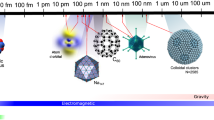Abstract
The assumption that hormonal feedback regulates ovarian follicle growth is used to formulate a many-body problem in which interactions are spatially independent. This mechanism of interaction is shown to be sufficient to account for the regulation of ovulation number. A method is also developed to test if this assumption is consistent with the observed spatial distribution of follicles in the Rhesus monkey ovary.
Similar content being viewed by others
References
A. Lipschütz, New developments in ovarian dynamics and the law of foilicular constancy,Br. J. Exp. Biol. 5:283–292 (1928).
R. E. Jones, Control of foilicular selection, inThe Vertebrate Ovary, R. E. Jones, ed. (Plenum Press, New York, 1978), Chapter 22, pp. 763–786.
N. B. Schwartz, The role of FSH and LH and of their antibodies on follicle growth and on ovulation,Biol. Reprod. 10:236 (1974).
A. J. Zeleznik, Premature elevation of systemic estradiol reduces serum levels of follicle stimulating hormone and lengthens the foilicular phase of the menstrual cycle in Rhesus monkeys,Endocrinology 109:352–355 (1981).
D. T. Baird, R. Horton, D. Longcope, and J. F. Tait, Steroid dynamics under steady state conditions,Recent Prog. Hormone Res. 25:611–664 (1969).
C. M. Cargille, G. T. Ross, and T. Yoshimi, Daily variation in plasma follicle stimulating hormone, luteinizing hormone, and progesterone in the normal menstrual cycle,J. Clin. Endocrinol. Metab. 29:12–19 (1969).
T. Pedersen, Follicle kinetics in the ovary of the cyclic mouse,Acta Endocrinol. 64:304–323 (1970).
L. Speroff and R. L. VandeWiele, Regulation of the human menstrual cycle,Am. J. Obstet. Gynecol. 109:234 (1971).
C. C. Tsai and S. S. C. Yen, Acute effects of intravenous infusion of 17b-estradiol on gonadotropin release in pre- and postmenopausal women,J. Clin. Endocrinol. Metab. 32:766–771 (1971).
C. M. Tapper and K. Grant-Brown, The secretion and metabolic clearance rates of estradiol in the rat,J. Endocrinol. 64:215–227 (1975).
E. Akin and H. M. Lacker, Ovulation control: The right number or nothing,J. Math. Biol. 20:113–132 (1984).
H. M. Lacker and E. Akin, How do the ovaries count?,Math. Biosci. 90:305–332 (1987).
H. M. Lacker, M. E. Feuer and E. Akin, Cell to cell signalling through circulatory feedback: A mathematical model of the mechanism of follicle selection in the mammalian ovary, inCell to Cell Signalling: From Experiments to Theoretical Models, A. Goldbeter, ed. (Academic Press, London, 1989), pp. 359–385.
H. M. Lacker, W. H. Beers, L. E. Meuli, and E. Akin, A theory of follicle selection: I. Hypotheses and examples,Biol. Reprod. 37:570–580 (1987).
H. M. Lacker, W. H. Beers, L. E. Meuli, and E. Akin, A theory of follicle selection: II. Computer simulation of estradiol administration in the primate,Biol. Reprod. 37:581–588 (1987).
L. E. Meuli, H. M. Lacker, and R. B. Thau, Experimental evidence supporting a mathematical theory of the physiological mechanism regulating follicle development and ovulation number,Biol. Reprod. 37:589–594 (1987).
H. M. Lacker, Temporal order and disorder in a model that regulates ovulation number, inTemporal Disorder in Human Oscillatory Systems, L. Rensing, U. an der Heiden, and M. C. Mackey, eds. (Springer-Verlag, Berlin, 1986), pp. 248–257.
A. McLaren, The distribution of eggs and embryos between sides in the mouse,J. Endocrinol. 27:157 (1963).
D. S. Falconer, R. G. Edwards, R. E. Fowler, and R. C. Roberts, Analysis of differences in the number of eggs shed by the two ovaries of mice during natural estrous and after superovulation,J. Reprod. Fertil. 2:418–437 (1961).
F. W. Brambell, Reproduction in the common shrew. I. The estrous cycle of the female, inPhilos. Trans. R. Soc. Lond. B Biol. Sci. 225:1 (1935).
F. W. Brambell and K. Hall, Reproduction in the lesser shrew,Proc. Zool. Soc. Lond. 106:957 (1936).
F. W. Brambell and I. W. Rowlands, Reproduction of the bank vole, Vol. 1. The estrous cycle of the female,Philos. Trans. R. Soc. Lond. B Biol. Sci. 226:71 (1936).
C. H. Danforth and S. B. de Aberle, The functional interrelation of the ovaries as indicated by the distribution of fetuses in mouse uteri,Am. J. Anat. 41:65 (1928).
J. D. Murray, G. F. Oster, and A. K. Harris, A mechanical model for mesenchymal morphogenesis,J. Math. Biol. 17:125 (1983).
Author information
Authors and Affiliations
Rights and permissions
About this article
Cite this article
Michael Lacker, H., Percus, A. How do ovarian follicles interact? A many-body problem with unusual symmetry and symmetry-breaking properties. J Stat Phys 63, 1133–1161 (1991). https://doi.org/10.1007/BF01030003
Received:
Issue Date:
DOI: https://doi.org/10.1007/BF01030003




